|
|
 |
|
Calanoida ( Order ) |
|
|
|
Diaptomoidea ( Superfamily ) |
|
|
|
Candaciidae ( Family ) |
|
|
|
Candacia ( Genus ) |
|
|
| |
Candacia ethiopica (Dana, 1849) (F,M) | |
| | | | | | | Syn.: | Candace ethiopica Dana,1849; Giesbrecht, 1892 (p.424, 439, 771, figs.F,M);
Ifionyx orientalis Kröyer,1849 (in Damkaer & Damkaer, 1979, p.42);
Candace melanopus Claus, 1863 (p.191);
Candacia aethiopica : Giesbrecht & Schmeil, 1898 (p.128, Rem. F,M); Thompson & Scott, 1903 (p.235, 250); Esterly, 1905 (p.196, figs.F,M); A. Scott, 1909 (p.150, Rem.); Wolfenden, 1911 (p.357); Sewell, 1912 (p.353, 366); 1914 a (p.228); Pesta, 1920 (p.537); Sars, 1925 (p.350); Rose, 1929 (p.39); Farran, 1929 (p.210, 272); Sewell, 1932 (p.334); Rose, 1933 a (p.254, figs.F,M); Tanaka, 1935 a (p.212, figs.F,M); Farran, 1936 a (p.114); Wilson, 1936 c (p.92); Mori, 1937 (1964) (p.85, figs.F,M); Wilson, 1942 a (p.174); Lysholm & al., 1945 (p.41); Sewell, 1947 (p.245); 1948 (p.322, 391, 396, 408, 412, 414, 422, 433, 437, 443, 457, 460, 469, 473); Moore, 1949 (p.60); C.B. Wilson, 1950 (p.180); Chiba & al., 1957 (p.310); 1957 a (p.11); Yamazi, 1958 (p.151, Rem.); Tanaka, 1960 (p.54); Furnestin, 1961 (p.327, figs.F,M); Ganapati & Shanthakumari, 1962 (p.9, 15); Gaudy, 1962 (p.93, 99, Rem.: p.113) ; Fagetti, 1962 (p.32); Brodsky, 1962 c (p.141, figs.M); Grice, 1962 (p.228, figs.F,M); Ahlstrom & Thrailkill, 1963 (p.57, Table 5, abundance); Duran, 1963 (p.23); Giron-Reguer, 1963 (p.52); V.N. Greze, 1963 a (tabl.2); Kasturirangan, 1963 (p.44, 47, figs.F,M); Björnberg, 1963 (p.57, Rem.); Mazza, 1964 (p.293, weight); De Decker & Mombeck, 1964 (p.11); Gobillard, 1964 (p.107, gregarine infestation, Rem.); Tanaka, 1964 (p.9); 1964 c (p.244); Chen & Zhang, 1965 (p.93, figs.F,M); Shmeleva, 1965 b (p.1350, lengths-volume -weight relation); Mullin, 1966 (p.546, Table I, III, diet); Chakroun, 1966 (p.67, Tableau); Mazza, 1966 (p.72); 1967 (p.329, 359, 377); Ehrhardt, 1967 (p.741, 887, figs.51-53, geographic distribution, Rem.); Fleminger, 1967 a (tabl.1); Vives, 1967 (p.559, fig.F); Evans, 1968 (p.11); Vinogradov, 1968 (1970) (p.78); Omori, 1969 (p.5, Table 1); Timonin, 1971 (p.281, trophic group); Deevey, 1971 (p.224); Carli, 1971 (p.372, tab.1); Lee & al., 1971 (p.1150); Apostolopoulou, 1972 (p.328, 363, fig.7); Brodsky & Kos, 1972 (Vol.I, figs.F,M, Rem.); Razouls, S, 1972 b (p.2, respiration); 1974 (147, oxygen rate); Gaudy, 1975 (p.109, fig.1, Table I, respiration); Frontier, 1977 a (p.16); Dawson & Knatz, 1980 (p.8, figs.F,M); Ponomareva & Suslyayev, 1980 (p.196, movement); Sazhina, 1982 (p.1159, fig. Nauplius); Vives, 1982 (p.294); Kovalev & Shmeleva, 1982 (p.85); Zheng & al., 1982 (p.63, figs.F,M); Guangshan & Honglin, 1984 (p.118, tab.); Scotto di Carlo & al., 1984 (1044); Sazhina, 1985 (p.66, figs.N); 1985 a (p.491, tab.3); Moraitou-Apostolopoulou, 1985 (p.303, occurrence/abundance in E Mediterranean Sea, Rem.: p.314); Petipa & Borichenko, 1985 (tab.1, 2); Regner, 1985 (p.11, Rem.: p.37); M. Lefèvre, 1986 (p.33); Ambler & Miller, 1987 (tab.2, 3, 4); Jimenez-Perez & Lara-Lara, 1988; Lozano Soldevilla & al., 1988 (p.60); Hernandez-Trujillo, 1989 a (tab.1); Cervantes-Duarte & Hernandez-Trujillo, 1989 (tab.3); Huntley & Lopez, 1992 (p.201, Table B1, growth rate, temperature-dependent production); Yen & al., 1992 (p.495, tab.1, mechanoreception); Noda & al., 1998 (p.55, Table 3, occurrence); Suarez-Morales & Gasca, 1998 a (p108); Hure & Krsinic, 1998 (p.102); Siokou-Frangou, 1999 (p.478); Seridji & Hafferssas, 2000 (tab.1); El-Sherif & Aboul Ezz, 2000 (p.61, Table 3: occurrence); Rebstock, 2001 (tab.2); Rebstock, 2001 (tab.2, 4); 2002 (p.71, Table 3, 4, climatic variability); Mackas & al., 2006 (L22S07, Table 2); Vukanic, 2003 (p.139, tab.1); Gallienne & al., 2004 (p.5, tab.3); CPR, 2004 (p.51, fig.142); Zuo & al., 2006 (p.162: tab.1); Lopez-Ibarra & Palomares-Garcia, 2006 (p.63, Tabl. 1, seasonal abundance vs El-Niño); Lavaniegos & Jiménez-Pérez, 2006 (p.136, tab.2, 4, Rem.); Mackas & al., 2006 (L22S07, Table 2); Mazzocchi & Di Capua, 2010 (p.424); Lidvanov & al., 2013 (p.290, Table 2, % composition); Palomares-Garcia & al., 2018 (p.178, Table 1: occurrence);
Canadacia aethiopica : Go & al., 1997 (tab.1, lapsus calami) | | | | Ref.: | | | Esterly, 1905 (p.196, figs.F,M); Dakin & Colefax, 1933 (p.206); 1940 (p.105, figs.F,M); Grice, 1963 (p.176, Rem.); Crisafi, 1963 (p.85, figs.F,M, juv.); Vervoort, 1965 (p.162, Rem.); Park, 1968 (p.566, Rem.F,M); Corral Estrada, 1970 (p.197, figs.F,M, Rem.); Razouls, 1972 (p.95, Annexe: p.85, figs.F,M); Lawson, 1977 (p.71, tab.2,3,4,fig.5); Carter, 1977 (1978) (p.36); Björnberg & al., 1981 (p.657, figs.F,M); van der Spoel & Heyman, 1983 (p.33); Chihara & Murano, 1997 (p.753, Pl.75,78: F,M); Mulyadi, 1997 a (p.90, Redescr.F,M, figs.F,M); Barthélémy & al., 1998 (p.721, genital area); Barthélémy, 1999 (fig. 12D); Bradford-Grieve & al., 1999 (p.885, 956, figs.F,M); Bradford-Grieve, 1999 b (p.169, figs.F,M, Rem., figs.182, 193); Conway & al., 2003 (p.109, figs.F,M, Rem.); Mulyadi, 2004 (p.88, figs.F,M, Rem.); Vives & Shmeleva, 2007 (p.449, figs.F,M, Rem.) |  issued from : O. Tanaka in Suisan Gakkai Ho, Tokyo, 1935, 6 (4). [Pl. III, p.221; Pl. IV, p.223]. As Candacia aethiopica. Female: 10, habitus (lateral view); 11, urosome (ventral view); 12, Mx2; 13, segment 3 of exopodite of P3; 14, P5. Male: 1, habitus (dorsal view); 2, last thoracic segment and urosome (right lateral view); 3, A1 (right side): hinge segments; 4, P5 (and left distal segment).
|
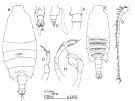 issued from : Bradford-Grieve J.M. in The Marine Fauna of New Zealand: Pelagic Calanoid Copepoda. National Institute of Water and Atmospheric Research (NIWA). NIWA Biodiversity Memoir, 111, 1999. [p.170, Fig.120]. Female: A, habitus (dorsal); B, urosome with spermatophore (ventral); C, idem (right lateral side); D, P5. Male: E, habitus (dorsal); F, anterior part of urosome (ventral); G, right A1; H, P5. Nota: The Southwest Pacific females and males were decorated on the dorsal surface of pedigerous segments with small spinules.
|
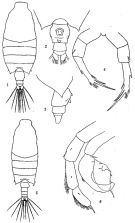 issued from: Q.-c Chen & S.-z. Zhang in Studia Marina Sinica, 1965, 7. [Pl.38, 1-6]. As Candacia aethiopica. Female (from E China Sea): 1, habitus (dorsal); 2, urosome (ventral); 3, idem (lateral right side); 4, P5 (posterior). Male: 5, habitus (dorsal); 6, P5 (posterior).
|
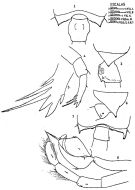 issued from : J. Corral Estrada in Tesis Doct., Univ. Madrid, A-129, Sec. Biologicas, 1970. [Lam.52, figs.2-8]. Female (from Canarias Is.): 2, posterior part cephalothorax and genital segment (dorsal); 3, idem (lateral left side); 4, P5; 5, distal part of P5.
|
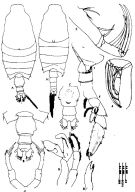 issued from : Mulyadi in Treubia, 1997, 31 (2). [p.91, Fig.8]. Female (from off N Celebes): A, habitus (dorsal); B, angles of the 5th metasomal somite and urosome (dorsal); C, urosome (ventral); D, Md (biting blade); E, Mx2; F, P3; G, P5 (posterior view). Nota: The female is distinguishable by the small ventrolateral spiniform orocesses of urosomite 1 and 7 spines on exopod of P5. Male: H, habitus (dorsal); I, angle of the 5th metasomal somite and urosomal segments 1 and 2 (lateral right side); J, Mx2; K, P5 (posterior view). Nota: The male is distinguishable by the right side of 5th metasomal somite with bifid apex and the urosomite 1 with 2 triangular processes on the right margin.
|
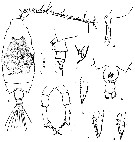 issued from : Z. Zheng, S. Li, S.J. Li & B. Chen in Marine planktonic copepods in Chinese waters. Shanghai Sc. Techn. Press, 1982 [p.64, Fig.36-1]. As Candacia aethiopica. Female: a, habitus (dorsal); b-c, urosome (ventral and lateral, respectively); d, Md (mandibular blade); e, exopodal segment 3 of P2; f, exopodal segment 3 of P3; g, distal part of exopodal segment 3 of P3; h, exopodal segment 3 of P4; i, P5. Scale bar in mm.
|
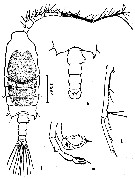 issued from : Z. Zheng, S. Li, S.J. Li & B. Chen in Marine planktonic copepods in Chinese waters. Shanghai Sc. Techn. Press, 1982 [p.65, Fig.36-2]. As Candacia aethiopica. Male: j, habitus (dorsal); k, urosome (dorsal); l, geniculate segments of A1. Scale bar in mm.
|
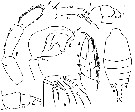 issued from : C.O. Esterly in Univ. Calif. Publs. Zool., 1905, 2 (4). [p.197, Fig.47]. As Candacia aethiopica. Female (from San Diego Region): a, habitus (dorsal); c, urosome (lateral); d, 2nd and 3rd segments of exopod of P3; e, P5; h, Mx2. Male: b, last thoracic segment and genital segment (dorsal); f, left P5; g, forceps of right P5.
|
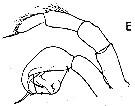 issued from : C. Razouls in Th. Doc. Etat Fac. Sc. Paris VI, 1972, Annexe. [Fig.54, E]. Male: E, P5.
|
 issued from : J.H. Wickstead in An Introduction to the study of Tropical Plankton, 1965 [I a]; Carnivorous copepod, Candacia ethiopica (female, most of the long antennae removed) has seized a myctophid fish larva. Note how the grasp is sufficiently strong to break the larva's back.
|
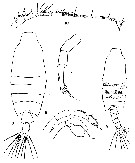 issued from : T. Mori in The Pelagic copepoda from the neighbouring waters of Japan, 1937 (1964). [Pl. 57, Figs.6-10]. As Candacia aethiopica. Female: 6, habitus (dorsal); 7, P5. Male: 8, P5; 9, habitus (dorsal); 10, right A1.
|
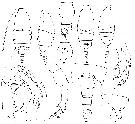 issued from : G.D. Grice in Fish. Bull. Fish and Wildl. Ser., 1962, 61. [p.230, Pl.29, Figs.5-16]. Female (from equatorial Pacific): 5-6, habitus (dorsal and lateral, respectively); 7, urosome (dorsal); 8, genital segment (ventral); 9, Md (biting edge); 10, Mx2; 11, P5. Nota: Of the two spine-like protrusions on the genital segment, the one on the left is the larger. Basal tooth of Md with 3 cusps, the middle one of which is the larger. Distal segment of P5 with 1 external spine, 3 terminal points and 3 internal, apparently unarticulated, setae Male: 12-13, habitus (dorsal and lateral, respectively); 14, posterior part of thorax and urosome (dorsal); 15, posterior lateral corner of thorax and genital segment (right side); 16, P5. Nota: A bifid spine-like protrusion in lateral view, extending from the right posterior margin of the thorax. There is a rounded tubercle and a spine-like point arising from the right side of the genital segment. Chela of the right P5 broad and spinous.
|
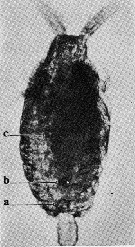 issued from : M.-O. Gobillard in Vie et Milieu, 1964, Supplt 17. [p.108, Fig.1]. As Candacia aethiopica parasited by Cephaloidophora petiti (Eugregarine). a: gut; b, Eugregarine; c, lipidique globule.
|
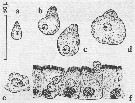 issued from : M.-O. Gobillard in Vie et Milieu, 1964, Supplt 17. [p.112, Fig.4]. As Candacia aethiopica from Banyuls, parasited by Cephaloidophora petiti. a-d, isolated cells: e-f, juvenils of the gregarine in the gut epithelium.
|
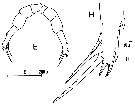 issued from : C. Razouls in Th. Doc. Etat Fac. Sc. Paris VI, 1972, Annexe. [Fig.53, E, H]. Female (from Banyuls, G. of Lion): E, P5; H, distal portion of P5 (enlarged).
|
 issued from : A.A. Shmeleva in Bull. Inst. Oceanogr., Monaco, 1965, 65 (n°1351). [Table 6: 34 ]. As Candacia aethiopica (from South Adriatic). Dimensions, volume and Weight wet. Means for 50-60 specimens. Volume and weight calculated by geometrical method. Assumed that the specific gravity of the Copepod body is equal to 1, then the volume will correspond to the weight.
|
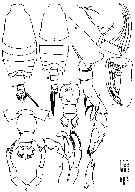 issued from : Mulyadi in Published by Res. Center Biol., Indonesia Inst. Sci. Bogor, 2004. [p.89, Fig.49]. Female (from o1°30'N, 124*00'E)): A, habitus (dorsal); B, angles of the 5th metasomal somite and urosome (dorsal); C, urosome (ventral); D, Md (biting blade); E, Mx2; F, P3; G, P5 (posterior view). Nota: The female is distinguishable by the small ventrolateral spiniform orocesses of urosomite 1 and 7 spines on exopod of P5. Male: H, habitus (dorsal); I, angle of the 5th metasomal somite and urosomal segments 1 and 2 (lateral right side); J, Mx2; K, P5 (posterior view). Nota: The male is distinguishable by the right side of 5th metasomal somite with bifid apex and the urosomite 1 with 2 triangular processes on the right margin.
|
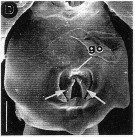 issued from : R.-M. Barthélémy in Thèse Doct. Univ. Provence (Aix-Marseille I), 1999. [Fig.12, D]. Female (from Tripoli coast, E Mediterranean Sea): B, external ventral view genital double-somite. go = genital operculum; Note the complex operculum with two lateral lobes (arrowed). Scale bar: 0.050 mm.
|
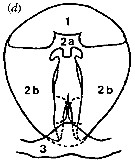 issued from : R.-M. Barthélémy, C. Cuoc, D. Defaye, M. Brunet & J. Mazza in Phil. Trans. R. Soc. Lond., B, 1998, 353. [p.729, Fig.54 d]. d, Schematic external genital area Candacia ethiopica. Nota: Compare with C. simplex, C. bispinosa and C. armata. Homologous structures have the same number: 1, anterior thickening of genital operculum; 2a, median part of genital operculum; 2b, lateral expansions of genital operculum; 3, posterior pad.
|
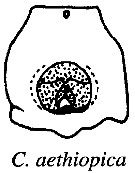 issued from : R.-M. Barthélémy, C. Cuoc, D. Defaye, M. Brunet & J. Mazza in Phil. Trans. R. Soc. Lond., B, 1998, 353. [p.733, Fig.63]. Schematic representation of external genital area in the species studied; Dashed line, limit of the anterior pad and lateral thickenings; shading, posterior pad; dots, genital operculum.
|
 Issued from : J.M. Bradford-Grieve, E.L. Markhaseva, C.E.F. Rocha & B. Abiahy in South Atlantic Zooplankton, edit. D. Boltovskoy. 1999, Vol. 2, Copepoda; [p.1065, Fig. 7.367: Candacia ethiopica ]. Gns = genital segment. Female characters (from key, p.956): - In lateral view, small protuberance arising from ventral side of genital segment near posterior margin; distal 2 inner setae on terminal segment of P5, coarse and unequal in length. - In dorsal view, spines from left and right sides of genital segment smaller and not reaching posterior margin of genital segment. - 3 inner edge setae present on terminal segment of P5. - Urosomal segment 2 without lateral or ventral protrusion and without spine-like process arising from ventral surface. Posterior corners of prosome pointed. Male characters (from key, p.956): - In dorsal view, process on right side of genital segment small, consisting of rounded knob in front of which is pointed projection. - Right prehensile A1 with segments 17 and 18 fused. - Right A1 with segments 2 and 3 fused. - In dorsal view, genital segment with small protrusion. - Left posterior corner of the prosome pointed.
|
 Issued from : W. Giesbrecht in Fauna Flora Golf. Neapel, 1892, 19. [Taf. 39, figs. 7, 13]. As Candace ethiopica. Male: 7, Thoracic segment 5 and abdominal segments 1 and 2 (dorsal). Female: 13, urosome (ventral).
|
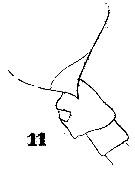 Issued from : W. Giesbrecht in Fauna Flora Golf. Neapel, 1892, 19. [Taf. 39, figs. 11]. Female: 11, Thoracic segment 5 and abdominal segment 1 and 2 (lateral).
|
 Issued from : K.A. Brodsky & M.C. Kos in Field guide for plankton. Zool Institute USSR Acad., Vol. I, 1972. As Candacia aethiopica. After Mori, 1937, from Brodsky, 1962 Female: 1, habitus; 3, last thoracic segment and abdomen (dorsal); 5, P5. Male: 2, habitus (dorsal); 4, A1; 6, P3; 7, P5
| | | | | Compl. Ref.: | | | Grice & Hulsemann, 1967 (p.19); Morris, 1970 (p.2301); Roe, 1972 (p.277, tabl.1, tabl.2); Corral Estrada & Pereiro Muñoz, 1974 (tab. I); Deevey & Brooks, 1977 (p.156, tab.2, Station "S"); Tranter, 1977 (p.596, 600); Dessier, 1983 (p.89, Tableau 1, Rem., %); De Decker, 1984 (p.317, 336: chart); Jansa, 1985 (p.108, Tabl. I, II, III, IV, V); Brenning, 1985 a (p.28, Table 2); Madhupratap & Haridas, 1986 (p.105, tab.1); Brenning, 1987 (p.30, spatial distribution, T-S diagram, Rem.); Dessier, 1988 (tabl.1); Madhupratap & Haridas, 1990 (p.305, fig.4: vertical distribution night/day; fig.7: cluster); Heinrich, 1990 (p.19); Ohtsuka & Kubo, 1991 (p.541); Shih & Young, 1995 (p.69); Moraitou-Apostolopoulou & al., 2000 (tab.I); Beaugrand & al., 2002 (p.179, figs.5, 6); Hsiao & al., 2004 (p.325, tab.1); Osore & al., 2004 (p.195); Razai & al., 2004 (p.490, tab.2); Hwang & al., 2006 (p.943, tabl. I); Hwang & al., 2007 (p.23); Dur & al., 2007 (p.197, Table IV); C.-Y. Lee & al., 2009 (p.151, Tab.2); Williamson & McGowan, 2010 (p.273, Table 3, Pacific central gyres: N and S); Cornils & al., 2010 (p.2076, Table 3); Schnack-Schiel & al., 2010 (p.2064, Table 2: E Atlantic subtropical/tropical); W.-B. Chang & al., 2010 (p.735, Table 2, abundance); Hsiao S.H. & al., 2011 (p.475, Appendix I); Tseng L.-C. & al., 2011 (p.47, Table 2, occurrences vs mesh sizes); Hsiao & al., 2011 (p.317, Table 2, indicator of seasonal change); Selifonova, 2011 a (p.77, Table 1, alien species in Black Sea); Shiganova & al., 2012 (p.61, Table 4); Uysal & Shmeleva, 2012 (p.909, Table I); Tseng & al., 2012 (p.621, Table 3: abundance); Belmonte & al., 2013 (p.222, Table 2, abundance vs. stations); in CalCOFI regional list (MDO, Nov. 2013; M. Ohman, pers. comm.); Tseng & al., 2013 (p.507, seasonal abundance); Schukat & al., 2013 (p.1, Table 1, 2, fig.2, respiration, ingestion); Bonecker & a., 2014 (p.445, Table II: frequency, horizontal & vertical distributions); Dias & al., 2015 (p.483, Table 2, abundance, biomass, production); Bode & al., 2015 (p.268, Table 1, chemical components, trophic level, geographic zone); Benedetti & al., 2016 (p.159, Table I, fig.1, functional characters); El Arraj & al., 2017 (p.272, table 2); Benedetti & al., 2018 (p.1, Fig.2: ecological functional group); Belmonte, 2018 (p.273, Table I: Italian zones); Bode & al., 2018 (p.840, Table 1, respiration & ingestion rates, depth) | | | | NZ: | 17 | | |
|
Distribution map of Candacia ethiopica by geographical zones
|
| | | | | | | | | | | |  issued from : T.J. Lawson in Marine Biology, 1977, 43. [Fig.5, p.79]. issued from : T.J. Lawson in Marine Biology, 1977, 43. [Fig.5, p.79].
Distribution map for the Indian Ocean. |
 issued from : Mulyadi in Treubia, 1997, 31 (2). [p.109, Fig.16]. issued from : Mulyadi in Treubia, 1997, 31 (2). [p.109, Fig.16].
Distribution of Candaciidae in Indonesian waters. 6: C. ethiopica. |
 issued from : U. Brenning in Wiss. Z. Wilhelm-Pieck-Univ. Rostock - 36. Jahrgang 1987. Mat.-nat. wiss. Reihe, 2. [p.27, Fig.1]. issued from : U. Brenning in Wiss. Z. Wilhelm-Pieck-Univ. Rostock - 36. Jahrgang 1987. Mat.-nat. wiss. Reihe, 2. [p.27, Fig.1].
Spatial distribution for Candacia curta, C. armata, C. bipinnata, C. paenelongimana, C. varicans (as varians), C. pachydactyla, C. longimana, C. ethiopica, Paracandacia simplex ( = C. simplex) from 8° S - 26° N; 16°- 20° W, for different expeditions (V1: Dec. 1972- Jan. 1973; V2: Feb/Mar. 1973; VI: May 1974; IV: Jun./Jul. 1972). |
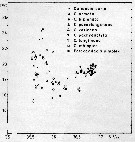 issued from : U. Brenning in Wiss. Z. Wilhelm-Pieck-Univ. Rostock - 36. Jahrgang 1987. Mat.-nat. wiss. Reihe, 2. [p.28, Fig.2]. issued from : U. Brenning in Wiss. Z. Wilhelm-Pieck-Univ. Rostock - 36. Jahrgang 1987. Mat.-nat. wiss. Reihe, 2. [p.28, Fig.2].
T-S Diagram for Candacia curta, C. armata, C. bipinnata, C. paenelongimana, C. varicans, C. pachydactyla, C. longimana, C. ethiopica, Paracandacia simplex ( = C. simplex) from 8° S - 26° N; 16°- 20° W. |
 Issued from S. Razouls in XXIII rd Congress of Athens, 3-11 November 1972. [p.2]. Issued from S. Razouls in XXIII rd Congress of Athens, 3-11 November 1972. [p.2].
As Candacia aethiopica. Oxygen consumed by individual (adult) in the Banyuls Bay and equivalent carbon asked.
(1) Hydrological season in the stability period: Eté = Summer: 18-20 °C; Hiver = Winter: 13-10°C.
Espèces = species; Saison = Season; Lg céph.= cephalothoracic length; an = individual. |
 Issued from : M. Madhupratap & P. Haridas in J. Plankton Res., 12 (2). [p.311, Fig.4]. Issued from : M. Madhupratap & P. Haridas in J. Plankton Res., 12 (2). [p.311, Fig.4].
Vertical distribution of calanoid copepod (mean +1 SE), abundance No/100 m3. 26- Candacia ethiopica.
Night: shaded, day: unshaded.
Samples collected from 6 stations located off Cochin (India), SE Arabian Sea, November 1983, with a Multiple Closing Plankton Net (mesh aperture 300 µm), in vertical hauls at 4 depth intervalls (0-200, 200-400, 400-600, 600-1000 m). |
 Issued from : M. Bode, R. Koppelmann, L. Teuber, W. Hagen & H. Auel inGlobal Biogeochemical Cycles, 2018, 32. [p.844, Table 1). Issued from : M. Bode, R. Koppelmann, L. Teuber, W. Hagen & H. Auel inGlobal Biogeochemical Cycles, 2018, 32. [p.844, Table 1).
Cf. explanations of these measures in Calanoides natalis from the same authors.
Compare with Candacia pachydactyla. |
| | | | Loc: | | | South Africa (E & W), Namibia, off Ascension Is., off NE St. Paul Is., Canary Is., off Morocco-Mauritania, off Madeira, Portugal, Brazil-Argentina, Campos Basin, Azores, off Amazon, G. of Mexico, Florida, Sargasso Sea, off Bermuda (Station "S"), Medit. (Alboran Sea, NW Basin, Baleares, Banyuls, G. of Lion, Marseille, Genoa, Naples, Tyrrhenian Sea, Messina, Gulf of Taranto, Adriatic Sea, Malta, Tripoli, Ionian Sea, Aegean Sea, N Lebanon Basin, Black Sea), Red Sea, Arabian Sea, Laccadive is., Maldive Is., Sri Lanka, Kenya, Mascarene Basin, Natal, Madagascar (Nosy Bé), India (Lawson's Bay), Bay of Bengal, S Indian Ocean, W Australia, Straits of Malacca, Indonesia-Malaysia, N Celebes, Philippines, China Seas (Yellow Sea, East China Sea, South China Sea), Taiwan (S, E, NW, NE), Okinawa, Japan, Kuchinoerabu Is., Izu region, Pacif. (tropical), Pacif. (W equatorial), Pacific (central gyres: N and S), Australia (Great Barrier, New South Wales, Shark Bay), New Caledonia, New Zealand (North Island NW), off W Kermadec Is., Galapagos, California, W Baja California, Bahia Magdalena, La paz, G. of California, off Peninsula of Alaska, off Aleutian Is., Bering Sea, Pacif. (equatorial, central subtropical N), Bikini Is., Caroline Is.-Marshall Is., Hawaii, off Hawaii NE, Fidji Is., Moorea Is., Central America, Pacif. (SE tropical), Galapagos, off Peru, off Chile | | | | N: | 178 (N Atlant.: 29; S Atlant.: 9; Medit.: 38; Black Sea: 1; Red Sea: 4; Indian: 33; Indo-Malaysia: 5; Pacif.: 55) | | | | Lg.: | | | (16) F: 2,52-2,22; M: 2,35-2,05; (34) F: 2,52-2,4; (46) F: 2,8-2,15; M: 2,25-2; (66) M: 1,96; (72) F: 3,03-2,47; M: 2,93-2,47; (91) F: 2,8-2,15; M: 2,3-2; (101) F: 2,21-1,97; M: 2,24-2,18; (104) F: 2,6; M: 2,4; (114) F: 2,81; (120) F: 2,57; M: 2,43; (142) F: 2,9; M: 2,5-2; (150) M: 2,25; (180) F: 2,47-2,4; M: 2,37; 2,35; (199) F: 2,51-2,28; M: 2,51-2,13; (237) F: 2,5-3,0; M: 2,0-2,5; (290) F: 2,5-2,25; M: 2,25-2; (334) F: 2,6; M: 2,4; (341) F: 2,96-2,56; M: 2,35-2,03; (342) F: 2,619-2,097; M: 2,576-1,956; (449) F: 2,8-2,15; M: 2,25-2; (778) F: 2,27; M: 2,21; (864) F: 2,02-2,38; (866) F: 1,97-2,83; (909) F: 2,2-2,65; M: 2-2,5; (920) F: 2,35; M: 2,16; (991) F: 1,97-3,03: M: 2-2,93; (1023) F: 2,63-2,83; M: 2,53-2,83; (1110) M: 2,3; (1230) F: 2,1-2,8; M: 2,0-2,6; {F: 1,97-3,03; M: 1,96-2,93}
The mean female size is 2.487 mm (n = 43; Sd = 0.3055), the mean male size is 2.286 mm (n = 40; SD = 0.2588). The size ratio (male : female) is 0.92 (n = 21; SD = 0.0705). | | | | Rem.: | epi-mesopelagic. Sargasso Sea: 0-500 m (Deevey & Brooks, 1977, Station "S");
After Grice (1963, p.176) Bowman has pointed out to him that the change in spelling of ethiopica to aethiopica by Giesbrecht & Schmeil (1898) has no justification. For C.B. Wilson (1950, p.180) in the Albatrosscollections the species is well distributed but nowhere abundant except off the west coast of Peru in a surface tow. The characteristic dark color of the appendages remains even after long preservation.
After Ponomareva & Suslyayev (1980, p.196) the average rates of movement is 2.8-57.6 m/hr.
After Ehrhardt (1967, p.888, 893) the species is found in the southwest Tyrrhenian Sea in water salinity between 37.76-38.14 p.1000 (mainly between 37.76- 37.80). For Moraitou-Apostolopoulou (1985, p.314) this species is found in large numbers in the north Aegean Sea.
Timonin (1971, p.282) considers the trophic interrelations in the equatorial and tropical Indian Ocean, and divides the plankters into 6 trophic groups from the litterature and the results of studies of mouth-parts structure and intestine content. This species is a piercing and sucking carnivorous.
After Benedetti & al. (2018, p.1, Fig.2) this species belonging to the functional group 2 corresponding to small ambush feeding carnivorous.
See in DVP Conway & al., 2003 (version 1) | | | Last update : 25/10/2022 | |
|
|
 Any use of this site for a publication will be mentioned with the following reference : Any use of this site for a publication will be mentioned with the following reference :
Razouls C., Desreumaux N., Kouwenberg J. and de Bovée F., 2005-2025. - Biodiversity of Marine Planktonic Copepods (morphology, geographical distribution and biological data). Sorbonne University, CNRS. Available at http://copepodes.obs-banyuls.fr/en [Accessed November 02, 2025] © copyright 2005-2025 Sorbonne University, CNRS
|
|
 |
 |






























